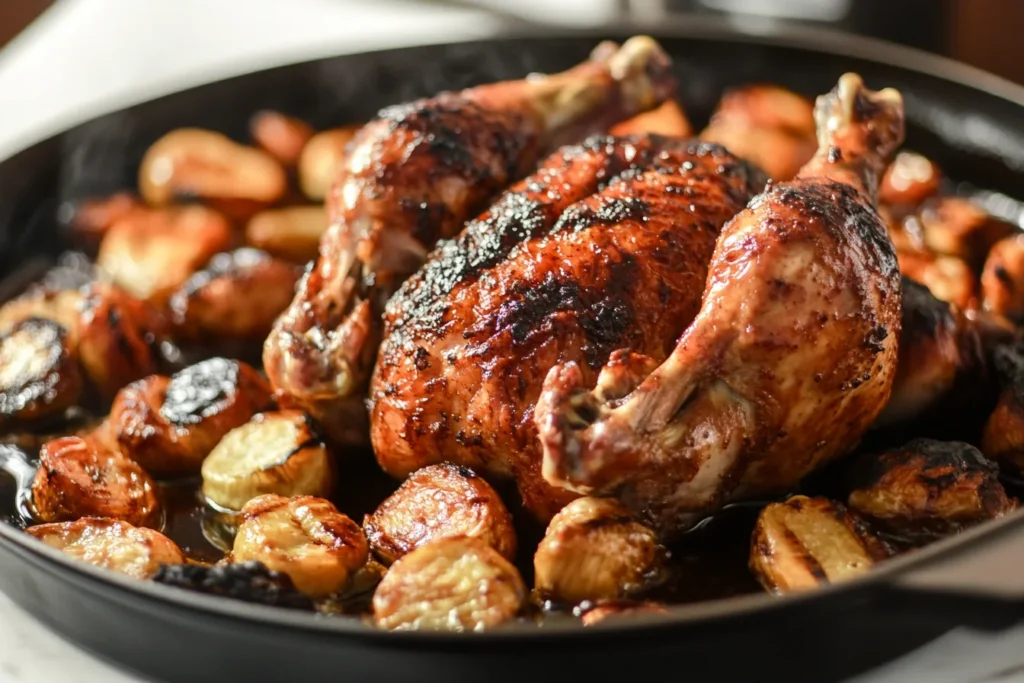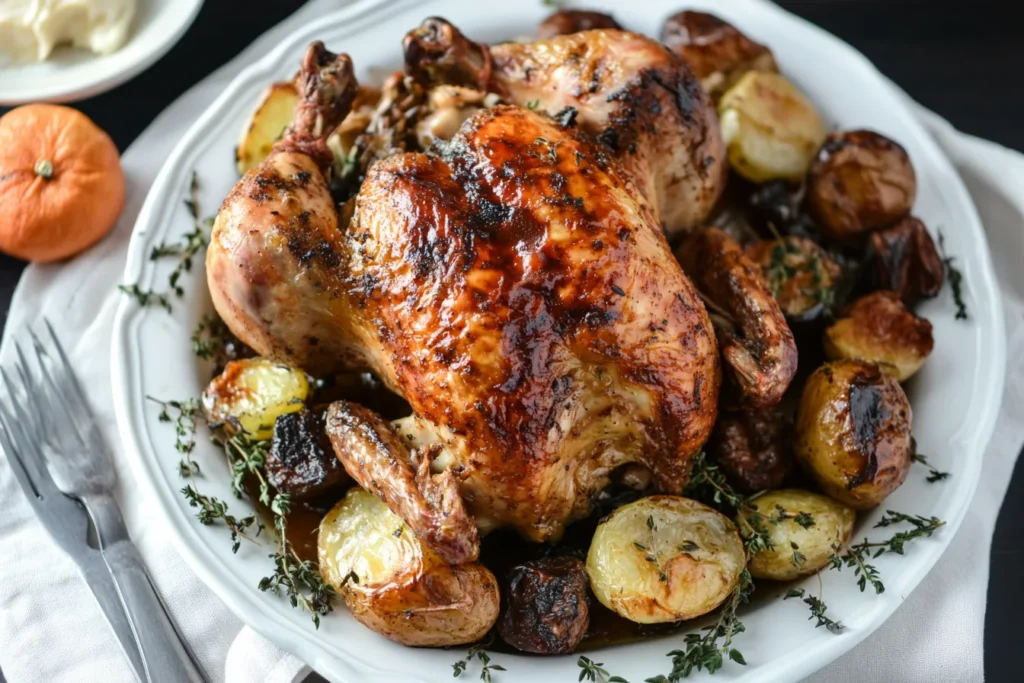Chicken has long been celebrated as a nutritional powerhouse, making it a staple in diets worldwide. Whether you’re a fitness enthusiast, a busy professional, or someone looking to make healthier eating choices, chicken offers a versatile and convenient source of high-quality protein. Among its most popular forms are the lean chicken breast and the flavorful rotisserie chicken, both of which have distinct nutritional profiles and culinary appeal.
Part 1: Introduction to Chicken as a Protein Source
The Importance of Chicken in a Balanced Diet

Chicken plays a vital role in a balanced diet due to its high protein content and relatively low fat, particularly when compared to red meat. Protein is essential for:
- Building and repairing tissues.
- Supporting immune function.
- Maintaining muscle mass during weight loss or aging.
While chicken breast has long been touted as the gold standard for lean protein, rotisserie chicken has gained popularity for its convenience and delicious, ready-to-eat appeal.
Nutritional Value of Chicken Breast and Rotisserie Chicken
Chicken breast is renowned for its simplicity and nutrient density. A typical 100-gram serving provides approximately:
- Calories: 165
- Protein: 31g
- Fat: 3.6g
- Sodium: Minimal (depending on preparation)
In contrast, rotisserie chicken often has added seasonings and fats, increasing the calorie and sodium count. A 100-gram serving may include:
- Calories: 200-240
- Protein: 25g
- Fat: 8-10g
- Sodium: Significantly higher (400-600mg)
Rotisserie chicken’s popularity comes from its convenience, often serving as a quick, ready-to-eat solution for busy households.
What is Rotisserie Chicken?
Rotisserie chicken is prepared using a rotating spit, which cooks the meat evenly while retaining its juiciness. The preparation often involves:
- Brining: Infusing the meat with a saltwater solution to enhance flavor and moisture.
- Seasoning: Adding a mix of herbs, spices, and sometimes sugar.
- Cooking: Slow-roasting the chicken to develop a crispy skin and tender meat.
This cooking method distinguishes it from grilled or baked chicken, which may lack the same level of seasoning or texture. However, these enhancements come at a cost: higher sodium and fat content.
Understanding Chicken Breast
Characteristics of Chicken Breast
Chicken breast is prized for its:
- Lean protein content.
- Versatility in recipes.
- Lower calorie and fat profile compared to other cuts.
Its neutral flavor allows it to pair seamlessly with various cuisines and cooking methods.
Cooking Methods and Their Impact
When cooking chicken breast, preparation significantly influences its nutritional value. Some common methods include:
- Grilling: Retains a smoky flavor with minimal fat.
- Baking: Preserves moisture when done correctly.
- Poaching: Keeps calories low but may lack flavor.
Each method retains the chicken’s lean profile but can influence texture and nutrient retention. Overcooking can dry out the meat, leading to a loss of vitamins and minerals.
Nutritional Comparison
Caloric Content
- Rotisserie Chicken: Higher in calories due to added oils and fats.
- Chicken Breast: Naturally lower in calories, ideal for weight management.
Macronutrient Breakdown
- Both options offer a high protein content, but chicken breast edges out due to its lower fat.
Sodium Levels
Rotisserie chicken can have up to six times more sodium than chicken breast. This is significant for individuals managing:
- Heart health.
- Blood pressure.
- Kidney function.
Additives and Flavor Enhancers
Rotisserie chicken often contains:
- Brining Solutions: Salt-heavy mixtures that increase water retention.
- Hidden Fats: Butter or oils injected under the skin.
- Preservatives: Used to maintain shelf life in store-bought varieties.
These additives improve taste and texture but can contribute to hidden calories and excess sodium intake. For those seeking to control their diet closely, chicken breast’s simplicity makes it a better choice.

Part 2: Health Considerations of Rotisserie Chicken and Chicken Breast
Health Considerations of Rotisserie Chicken
Rotisserie chicken has become a go-to option for many due to its convenience, flavor, and affordability. However, it is essential to examine its potential health implications closely.
Sodium Levels and Heart Health
One of the most significant drawbacks of rotisserie chicken is its high sodium content. The brining and seasoning process infuses the chicken with salt to enhance its flavor and juiciness, but this can lead to:
- Increased blood pressure: Excess sodium may contribute to hypertension.
- Strain on the heart: High sodium levels force the heart to work harder, increasing the risk of cardiovascular issues.
For individuals with conditions like high blood pressure or heart disease, the sodium content of rotisserie chicken can be a cause for concern.
Potential Preservatives and Their Effects
Store-bought rotisserie chickens often contain preservatives to extend shelf life, such as:
- Phosphates: Linked to kidney damage when consumed in high quantities.
- MSG (Monosodium Glutamate): Commonly used to enhance flavor, though it may cause sensitivities in some individuals.
While these additives are generally recognized as safe, they may not align with clean eating goals or dietary restrictions.
Benefits as a Quick Protein Source
Despite its drawbacks, rotisserie chicken has merits:
- Protein content: Still a high-protein option, even with added seasonings.
- Time-saving: Ideal for busy individuals seeking a nutritious meal without extensive preparation.
- Versatility: Works well in salads, sandwiches, and wraps, making it adaptable for various meals.
Health Considerations of Chicken Breast
Chicken breast remains the gold standard for lean protein. However, even this healthy option has considerations that impact its nutritional profile.
Benefits of Lean, Unseasoned Chicken Breast
Chicken breast is a top choice for those focused on:
- Weight management: Low in calories and fat, making it suitable for calorie-conscious diets.
- Muscle building: High protein content aids in muscle repair and growth.
- Heart health: Minimal sodium and saturated fat, supporting cardiovascular well-being.
Risks of Overcooking and Nutrient Loss
Cooking chicken breast improperly can lead to:
- Loss of nutrients: Overcooking reduces water-soluble vitamins, like B vitamins.
- Dry texture: Overcooked chicken breast can become unappetizing, making it less likely to be consumed regularly.
To avoid these issues, opt for methods like grilling, baking, or poaching with proper timing to retain nutrients and flavor.
Cooking Methods and Their Effects
Cooking methods play a pivotal role in determining the nutritional profile of both rotisserie chicken and chicken breast. Here’s how popular methods stack up:
Grilling
- Pros: Imparts a smoky flavor, minimal fat added.
- Cons: Can char the meat, creating harmful compounds like HCAs (heterocyclic amines).
Baking
- Pros: Even cooking without added fats.
- Cons: Requires careful monitoring to prevent dryness.
Frying
- Pros: Enhances flavor and texture.
- Cons: Adds significant fat and calories, often negating health benefits.
Rotisserie Cooking
- Pros: Retains moisture, providing tender meat.
- Cons: Typically involves added sodium, fats, and flavor enhancers.
Portion Sizes and Consumption Patterns
Understanding appropriate portion sizes is crucial to balancing health and indulgence.
Portion Sizes
- Chicken Breast: A standard serving is 3-4 ounces (approximately the size of a deck of cards), offering around 25-30 grams of protein.
- Rotisserie Chicken: Easy to overeat due to its flavorful skin and tender meat, with a typical serving exceeding the recommended portion size.
Risks of Overeating
Rotisserie chicken’s rich seasonings and juicy texture can lead to larger portions, which may:
- Increase calorie intake.
- Amplify sodium consumption.
- Disrupt dietary goals for weight loss or sodium reduction.

Who Should Choose What?
Choosing between rotisserie chicken and chicken breast depends on individual dietary needs and goals.
Rotisserie Chicken Is Best For:
- Busy individuals: Quick and ready-to-eat, suitable for hectic lifestyles.
- Moderate diets: Those who prioritize convenience but keep an eye on sodium intake.
- Family meals: Provides a cost-effective way to feed multiple people.
Chicken Breast Is Best For:
- Weight loss: Low in calories, high in protein.
- Muscle building: Provides a clean protein source for post-workout recovery.
- Special diets: Ideal for low-sodium or clean-eating plans.
Practical Tips for Healthier Choices
- Rotisserie Chicken: Remove the skin to cut down on fat and sodium. Pair with fresh vegetables to balance the meal.
- Chicken Breast: Experiment with herbs and spices instead of salt for flavor. Marinate with olive oil and citrus to enhance taste without adding unhealthy fats.
Part 3: Environmental and Ethical Impacts, Cost Analysis, and Recipes
Environmental and Ethical Impacts
When choosing between rotisserie chicken and chicken breast, it’s essential to consider the broader implications, including their environmental footprint and ethical concerns.
Ethical Considerations of Rotisserie Chicken
Rotisserie chicken is often sourced from factory farms, which can raise ethical concerns about:
- Animal welfare: Intensive farming practices may compromise the quality of life for chickens.
- Use of antibiotics: Common in large-scale farming to prevent disease, potentially contributing to antibiotic resistance.
If ethically sourced food is a priority, look for rotisserie chicken labeled as organic, free-range, or antibiotic-free.
Environmental Impacts
The production and preparation of chicken can contribute to:
- Carbon footprint: Factory-farmed chickens require significant resources for feed and transportation.
- Plastic packaging: Pre-packaged rotisserie chickens often come in disposable containers, adding to environmental waste.
Chicken breast, particularly when purchased fresh or in bulk, offers a more eco-friendly option. Cooking it at home reduces waste associated with packaging and processing.
Cost Analysis
For many households, cost plays a significant role in food choices. Comparing rotisserie chicken and chicken breast highlights some stark differences.
Price of Rotisserie Chicken
Rotisserie chickens are typically sold ready-to-eat, offering excellent value for money. A fully cooked chicken costs around $5-$8 at grocery chains, making it:
- Affordable for families.
- Convenient with no preparation time.
Price of Chicken Breast
Chicken breast, though more versatile, tends to be pricier when compared weight-for-weight to rotisserie chicken. However, buying in bulk or during sales can lower costs significantly. Additionally:
- Homemade preparation allows for precise portioning, minimizing waste.
- Bulk buying reduces cost per serving in the long run.
Verdict: Rotisserie chicken wins for short-term cost and convenience, while chicken breast offers better value for money in terms of nutritional content and long-term use.
Convenience vs. Health
Convenience is often a trade-off when it comes to food. While rotisserie chicken offers unparalleled ease, chicken breast provides more control over nutritional content.
Rotisserie Chicken: The Convenience King
- Pre-cooked: No time spent cooking, perfect for last-minute meals.
- Versatile: Can be used in salads, soups, or eaten as-is.
- Storage: Refrigerates well for up to 3-4 days.
Chicken Breast: The Health-Conscious Choice
- Customizable: Allows full control over seasoning and cooking methods.
- Meal prep potential: Easily batch-cooked for the week, saving time without sacrificing health.
If time is a constraint, consider blending the two options: enjoy rotisserie chicken occasionally but focus on prepping chicken breast for healthier meals during the week.
Recipes and Healthy Adaptations
Chicken is one of the most adaptable proteins. Here are a few ideas to make the most of each option:
Healthy Rotisserie Chicken Recipes
- Rotisserie Chicken Salad:
- Mix shredded rotisserie chicken with spinach, cherry tomatoes, cucumbers, and a light vinaigrette.
- Omit the skin to lower fat content.
- Add avocado for healthy fats.
- Chicken Soup:
- Use rotisserie chicken in a broth with carrots, celery, and whole-grain noodles.
- Opt for low-sodium broth to offset the chicken’s saltiness.
- Chicken Lettuce Wraps:
- Sauté shredded chicken with ginger, garlic, and soy sauce.
- Serve in romaine lettuce cups for a low-carb meal.
Chicken Breast Recipes
- Grilled Chicken and Quinoa Bowl:
- Grill seasoned chicken breast and pair with quinoa, roasted vegetables, and a dollop of hummus.
- Perfect for meal prep.
- Baked Lemon Herb Chicken:
- Marinate chicken breast in olive oil, lemon juice, garlic, and fresh rosemary.
- Bake until golden and juicy.
- Chicken Stir-Fry:
- Slice chicken breast thin and cook with broccoli, bell peppers, and a homemade teriyaki sauce.
- Serve over brown rice or cauliflower rice.
Expert Opinions and Studies
Several studies and nutrition experts weigh in on the debate between rotisserie chicken and chicken breast:
- Rotisserie Chicken: Offers convenience but should be consumed in moderation due to its sodium and fat content.
- Chicken Breast: Praised for being a lean, versatile, and nutrient-dense protein source.
For example, a study published in the American Journal of Clinical Nutrition highlighted the importance of lean protein sources like chicken breast in reducing heart disease risk. Meanwhile, dietitians emphasize removing the skin from rotisserie chicken to make it a healthier choice.
Conclusion
In the battle of rotisserie chicken vs. chicken breast, there is no one-size-fits-all answer. The choice depends on your:
- Dietary goals: For weight loss or muscle gain, chicken breast is ideal.
- Time constraints: Rotisserie chicken is the better option when convenience is key.
- Nutritional preferences: Chicken breast offers lower sodium and fat, making it a cleaner choice for those watching their intake.
By incorporating both options thoughtfully, you can enjoy the flavors and benefits of chicken without compromising your health.
More FAQs:
- Is rotisserie chicken processed food?
While not heavily processed, it often contains added seasonings, sodium, and preservatives. - Can I eat chicken breast daily?
Yes, it’s a healthy lean protein, but balance it with other protein sources for variety. - What’s the healthiest part of rotisserie chicken?
The meat without the skin is lower in fat and calories. - How do I reduce sodium in rotisserie chicken?
Remove the skin and rinse the meat before eating. - Is chicken breast good for weight loss?
Absolutely, due to its low calorie and high protein content. - Does rotisserie chicken contain added sugars?
Some seasonings may include sugar; check labels if it’s store-bought. - What’s better for meal prep: rotisserie chicken or chicken breast?
Chicken breast offers more flexibility and a cleaner nutritional profile. - Can I freeze leftover rotisserie chicken?
Yes, freeze in airtight containers for up to 3 months. - Are there organic rotisserie chickens?
Some grocery stores offer organic options with fewer additives. - Is grilled chicken healthier than rotisserie chicken?
Generally, yes, as it typically contains less sodium and added fat.
Related Article : How do you make leftover rotisserie chicken moist?

